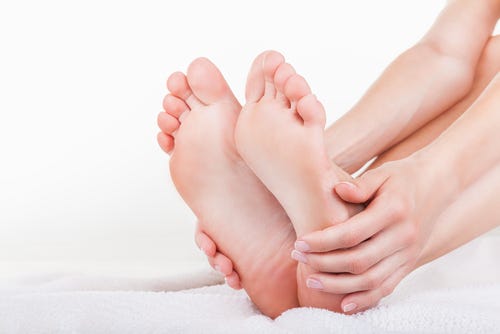Staying steady on your feet
Why does Cosyfeet have an interest in falls awareness?
Every year in the UK about one-third of people over 65 will fall. This rises to almost half of people aged 80 and above.
Cosyfeet footwear is designed for people with swollen feet, a condition that’s common amongst older people due to factors such immobility, medical conditions and the side effects of medication. As many of our customers are in the age group that is vulnerable to falls, we want to highlight the importance of falls prevention from a footwear and foot care point of view.
We know from talking to customers, and health professionals who recommend our footwear, that good foot care along with appropriate footwear plays a big part in preventing falls and maintaining mobility and independence.
With this mind, we have put together this leaflet based on advice and information from Age UK. The charity launched Falls Prevention Week in 2006 to highlight the importance of preventing falls and to challenge the belief that falling is an inevitable part of ageing.

Facts about falls
Falls and fractures in people aged 65 and over account for over 4 million hospital bed days each year in England alone.
- Falls destroy confidence, increase isolation and reduce independence
- They represent over half of hospital admissions for accidental injury
- Every year in England more than 223,000 people over 60 have a fracture due to a fall.
- 10% of hip-fracture patients will die within a month of their fracture and 30% will die within a year
- The annual cost of falls for people over 60 is £2 billion a year
Foot related risk factors for falls include:
- Unsuitable or loose fitting footwear such as sloppy slippers
- Going barefoot indoors
- Wearing socks or hosiery without shoes
- Foot pain
- Stiffness in feet and ankles
- Weakness and deformities such as bunions and claw toes
- Toenail disorders
What can we do to help prevent falls?
There are some simple things that people can do to help themselves stay steady on their feet. One of those is looking after their feet and wearing the right footwear.
A study published in the British Medical Journal in 2011 found that a multi-faceted foot care programme can reduce the number of falls by 36%. This includes foot and ankle exercises, foot orthoses and advice on appropriate footwear.
Footwear
Some footwear can increase the risk of slips, trips and falls. It can cause poor balance and gait or make it difficult to judge surface friction and distance from the floor.
Older people should be advised about the importance of wearing well-fitting shoes and about the characteristics that can aid walking and gait. These include:
- A high back or collar to support the ankle
- A hard, slip-resistant sole
- Heel height lower than one inch
It is also recommended that older people wear well-fitted, slip-resistant slippers or house shoes indoors rather than walking barefoot or in socks or tights.
What makes a shoe safe or unsafe?
Examples of safe outdoor footwear
|
|
||
| Cosyfeet 'Debbie' style | Cosyfeet 'Heaven' style | Cosyfeet 'Paradise' style |
- A firm heel to provide stability
- A low, broad heel to maximise contact with the ground
- A flexible, lightweight, slip-resistant sole
- Adjustable fastenings that can be firmly secured
The above Cosyfeet styles fulfil all the criteria for safe footwear. However, please note that these styles are specially designed for people with swollen feet and are unsuitable for people with ‘normal’ or narrow fittings.
Safe indoor footwear
|
|
||
| Cosyfeet 'Helen' slipper |
Cosyfeet 'Amelia' |
Cosyfeet 'Ryan' slipper |
- A strong fastener on the front to ensure they won't slip off
- A wide opening to make it easy to get your foot in and out of the slipper which is important if you have restricted mobility
- A house-shoe (such as the Amelia style above) offers the comfort of a slipper but with the stable support of a shoe.
Please note that these styles are specially designed for people with swollen feet and unsuitable for people with ‘normal’ or narrow fittings.
Examples of unsafe shoes and slippers
|
|
||
| Slip on shoes or slippers | Flip flops | High heels |
- Loose, worn or backless slippers are one of the most common causes of older people falling
- Slip-on shoes such as sling backs or flip flops can slip and trip you up
- Shoes with slippery or worn soles can cause you to slip up, especially in wet weather
- Shoes with a heel higher than one inch or with a narrow heel as they make your foot unstable and can cause your ankle to turn
Foot care
Foot conditions such as bunions, claw toes, ingrown toe nails and general foot pain can all cause problems with gait and balance.
Older people should be advised to check their feet regularly and speak to their GP or podiatrist if they have any reduction in foot sensation or develop foot pain.
Following a simple foot care routine can help reduce the risk of falls by preventing some of the conditions that cause pain and problems. This includes:
- Washing and drying feet daily to prevent infection
- Applying moisturiser to keep skin healthy
- Cutting toenails regularly
- Regular podiatry for the management of foot problems

Exercise - foot and ankle exercises
Exercise plays a vital role in falls prevention. Research trials have shown that a programme of strength and balance can be very effective in reducing the risk. Older people should be encouraged to carry out regular exercise to improve toe and ankle strength as this can help improve balance.



